If you are looking for a low-maintenance, shade-loving perennial that will reward you with colorful blooms, then growing astilbe is the answer for you!
While most shade-loving perennials like hostas and ferns only provide mounded green foliage, astilbe is different. Astilbe produces colorful spiky blooms along with attractive year-round foliage.
Their blooms can range in color from white, pink, purple and red, to nearly everything in between. Even better, they are long lasting too. Each astilbe bloom can last four to six weeks! And after blooms are finished, the foliage continues to add texture and beauty to your property for all-season interest.
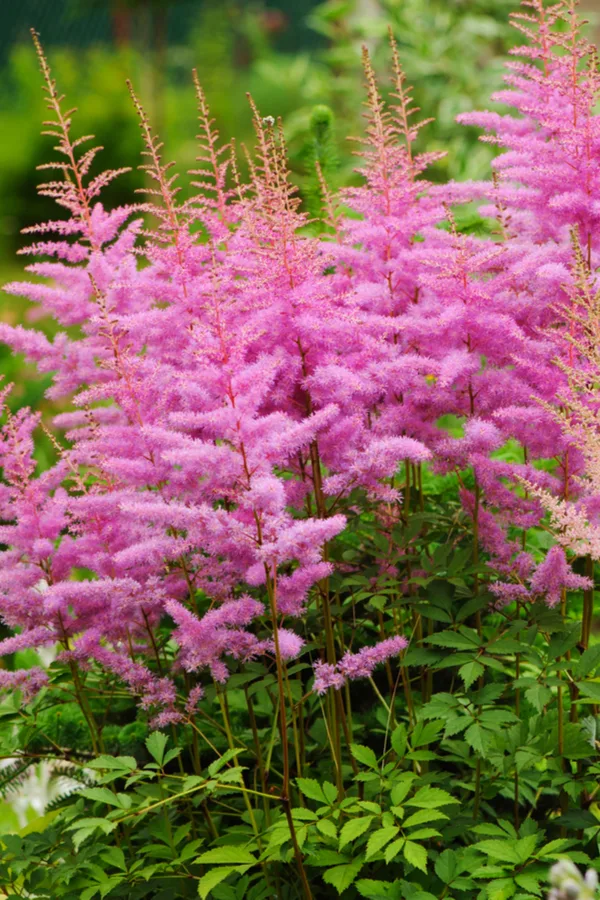
Their colorful blooms not only look beautiful, but they are also great for attracting pollinators to your property. In addition to attracting bees and butterflies galore, astilbe is also deer and rabbit resistant, allowing those animals to move on to other properties while leaving yours alone.
Astilbe is a herbaceous perennial that grows well in zones 4 through 9. It grows from rhizomes under the soil, which allows it to spread out in clumps as it grows each season.
Varieties of Astilbe – Growing Astilbe
There are around 25 different species of astilbe available and many hundreds of hybrids of each. Some plants grow only to be a few inches tall while others can be up to five feet in height. Their bloom clusters can be around half a foot across while others end up at 24 inches or more.
Some varieties of astilbe bloom during late spring, some in summer, and others bloom in the fall. By planting some of each type, you can enjoy astilbe blooms in all three seasons.
How To Plant, Grow And Maintain Astilbe
With the proper soil, watering, and a bit of care throughout their blooming season, astilbe is a great addition to any property.
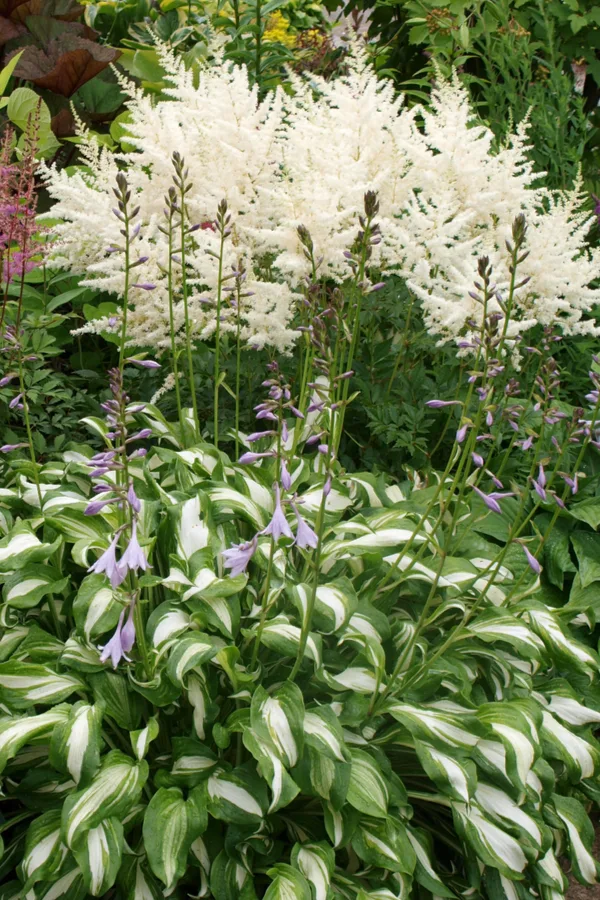
Consider growing it in flowerbeds, along property borders, or even in containers with other perennials. Unlike annual flowers, astilbe will keep on providing you with colorful blooms without the need to replant each year.
Soil Requirements for Astilbe
Astilbe flowers favor a slightly acidic pH of around 6.0. They also grow best in soil that is rich in organic matter. Be sure to add plenty of compost to existing soil, especially if you have clay-like or rocky soil. Not only will the compost help to add nutrients to the soil, but it will also help with drainage.
Loosen the soil about 6 to 10 inches deep in the area you are going to plant in. Add in a few inches of compost and work it well into the soil prior to planting.
Planting Astilbe – Growing Astilbe
It is often difficult to get astilbe to grow from seeds. Instead, you can purchase starts from most garden centers in early spring. Online garden retailers also carry astilbe bareroots, but be sure to choose a variety that thrives in your growing location.
You can also get astilbe starts from existing plants. Ask neighbors or other people in your community if they plan on dividing their established plants in the spring. This is a great way to ensure you are getting a variety that can thrive in your local soil and weather conditions.
Planting Outdoors
Aim for getting astilbe in the ground early in the springtime after the threat of frost has passed and the soil is workable. Choose a location that receives light to partial shade. Full shade may result in a reduction of blooms. In fact, astilbe can actually benefit from some dappled sunlight for a few hours each day.
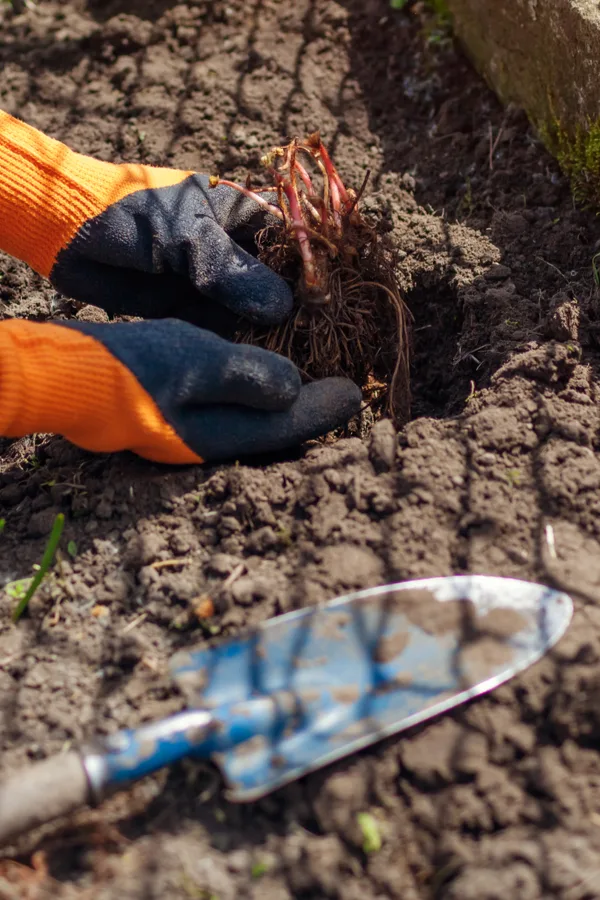
For transplants, loosen the soil slightly deeper and wider than the root ball’s length. For bareroot plants, dig a hole that is double the width of the root and about 6 inches deep. Slightly fan out the roots downward in all directions when placed in the soil.
Ensure that the crown is 1 to 2 inches below the soil line. Backfill with soil and lightly tamp down. If you didn’t amend the soil earlier with compost, be sure to add a few inches to the hole prior to backfilling. Water deeply. Space additional plants at least 12 to 16 inches apart.
Long-Term Care – How To Grow and Maintain Astilbe
Watering
Astilbe thrives with constant moisture, especially during the hot summer months. They do not do well with drought. While you want to avoid standing water around plants, aim for watering astilbe every couple of days.
Instead of lightly watering the plants, be sure to give a deep watering. This helps to ensure that the roots of the plant drive down in search of water instead of just staying at the surface of the soil. As with most plants, water at the base and avoid watering over the foliage and blooms.
Mulching
Adding mulch to the base of plants is a great way to help retain moisture and soil temperatures and keep astilbe growing strong and healthy. Use an all-natural mulch such as hardwood bark, shredded hardwood or even straw or grass clippings.
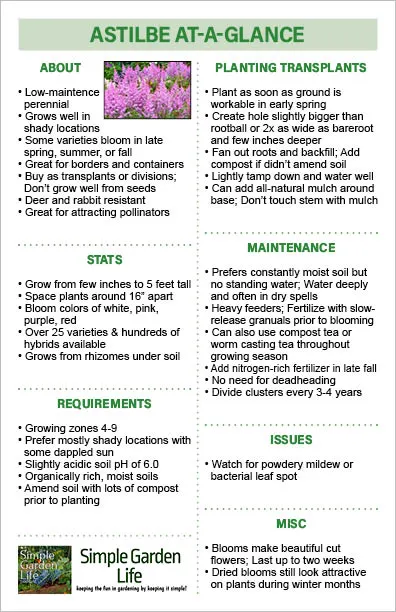
Be sure to keep the mulch from touching the stem of plants. Also, prior to the first hard frost in the fall, add a few inches of mulch around the base of plants as well. This will help to protect the roots throughout the winter season.
Fertilizing
During their blooming season, astilbe plants are heavy feeders so they can benefit from the help of fertilizer. You can provide them with a slow-release granular fertilizer prior to blooming to give them an extra boost.
Mix the granules into the soil at the base of the plant. Avoid getting it on the foliage as this will burn delicate leaves and plants. Water well.
Providing astilbe with the occasional drink of compost tea or worm casting tea is also beneficial throughout their growing season. The low and steady nutrients for either help develop strong root systems and better foliage. (For more making and using compost tea, check out our article: How To Make And Use Compost Tea – The Best All-Natural Fertilizer Around!)
In addition, add a nitrogen-rich fertilizer in the fall after plants have finished blooming. This will give plants a head start for their spring growth.
Deadheading & Pruning
Due to its low maintenance, you do not have to deadhead or prune astilbe plants. Doing so will not encourage additional blooms to form.
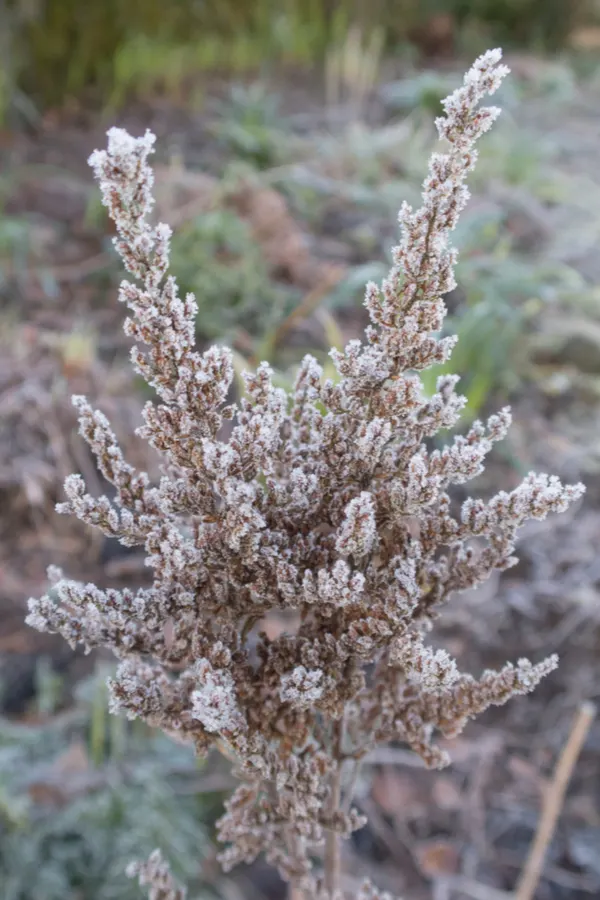
In fact, dried blooms add texture and visual interest if left on the plant. However, you may choose to cut back flowers if they start to look a little drab or have suffered drought or heat damage to encourage new growth in the following spring. The foliage alone will continue to stay attractive throughout the winter season.
Pests & Issues
Thankfully, astilbe is a relatively pest, disease, and issue-free plant to grow. However, it can be susceptible to powdery mildew in overly damp and humid conditions. They can also experience bacterial leaf spots.
Don’t be surprised if your astilbe plants don’t flower well in their first year. Often, plants won’t become established and start to produce blooms until the second year.
Occasionally, the crowns can rise above the soil line as the plants grow. If this occurs, you can either replant the crowns in the spring or you can add additional soil to ensure it stays completely underground.
Dividing
In order to maintain the health of astilbe plants, you should divide plants every three or four years. In the early spring, use a garden spade, shovel, or a hori hori tool to split up the thick roots. Each plant should be divided into three or four pieces.
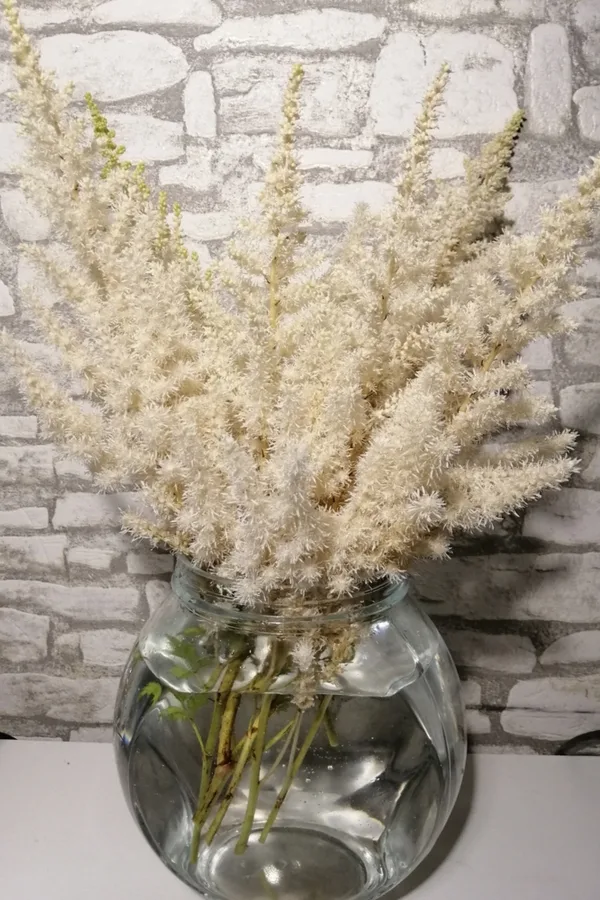
Replant the pieces as noted above and water well and often to help establish plants. You can also keep the divisions in containers until you are ready to plant them in the ground.
Cut Flowers
Astilbe blooms make great cut flowers. Cut the blooms off with several inches of stem attached. Immediately place in a vase with clean water. The blooms can last up to about two weeks.
Here is to adding some pizazz to the less sunny areas of your landscape. For more ideas on great plants to grow in the shade check out “The Best Perennials To Grow In The Shade.”
Follow Our Facebook Page For Even More Great Tips! Simple Garden Life Facebook Page
Simple Garden Life is a website dedicated to keeping gardening fun, simple and enjoyable! We publish two new articles each week along with a new garden podcast episode every two weeks. This article may contain affiliate links.
Feel free to download, print out, or save our Astilbe At-A-Glance sheet. It is sized for half letter printing but can be scaled if needed.
